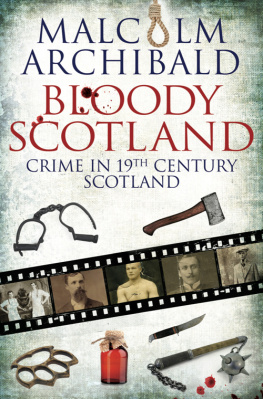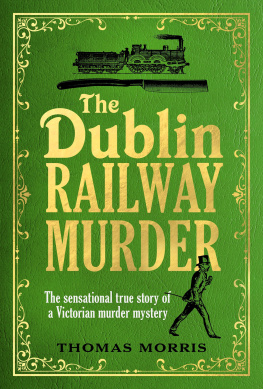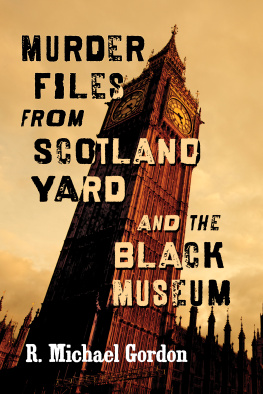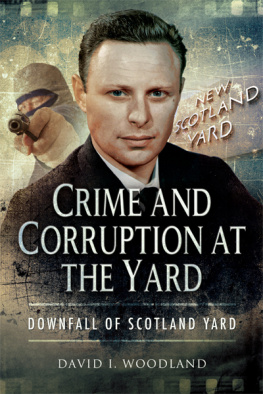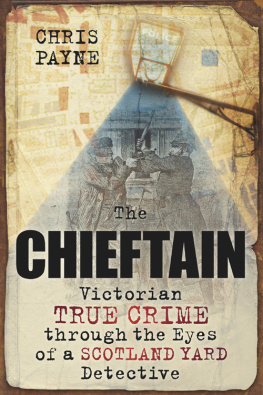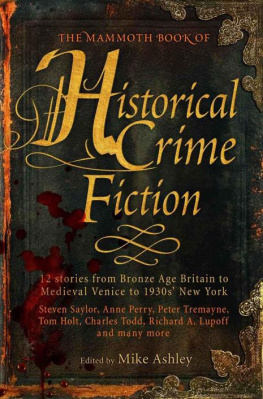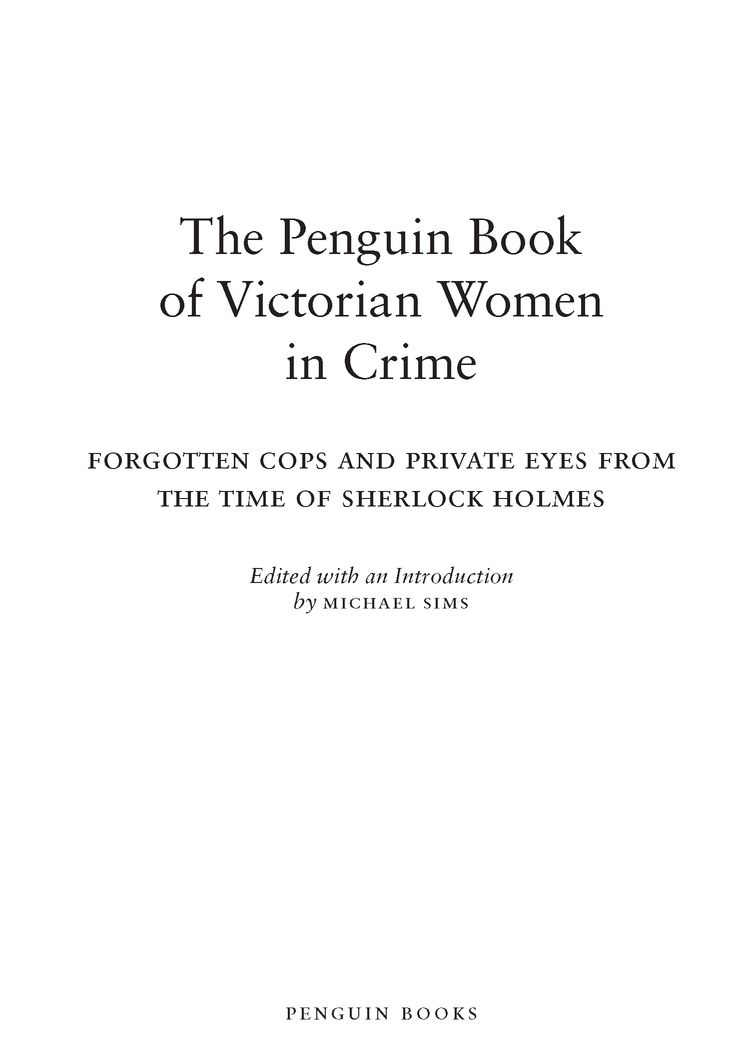Table of Contents
THE PENGUIN BOOK OF VICTORIAN WOMEN IN CRIME
MICHAEL SIMS is the author of several nonfiction books, including Apollos Fire: A Day on Earth in Nature and Imagination, Adams Navel: A Natural and Cultural History of the Human Form, and most recently In the Womb: Animals, a companion book to a National Geographic Channel TV series. For Penguin Classics he has edited The Annotated Archy and Mehitabel; Arsne Lupin, Gentleman-Thief; and The Penguin Book of Gaslight Crime; and he introduced The Leavenworth Case by Anna Katherine Green. He is also the editor of Draculas Guest: A Connoisseurs Collection of Victorian Vampire Stories. His work has appeared in the Washington Post, Orion, the Times of London, New Statesman, and Chronicle of Higher Education. Learn more at www.michaelsimsbooks.com.
Acknowledgments
Once again I thank the admirable team at Penguin Classics, who have been a dream to work with, and who even sent care packages of books and cookies while I recovered from a car wreck. My thanks to editorial director Elda Rotor, who is helpful and patient and who wears great colors; her intrepid and eagle-eyed assistant, Lorie Napolitano; publicity director Maureen Donnelly; publicists Meghan Fallon and Courtney Allison; Bennett Petrone, associate director of publicity; cover designer Jaya Miceli; and production editor Jennifer Tait.
I welcome this opportunity to thank Elizabeth Carolyn Miller, assistant professor of English at the University of California at Davis, for her generosity in providing copies of her insightful articles and for her critique of my introduction to this volume as well as my introduction to Penguins edition of Anna Katharine Greens novel The Leavenworth Case (and thanks for tea at MLA). Thank you also to Arlene Young, assistant professor of English at the University of Manitoba, for her critiques and advice and her generosity in sending her own article. Several people generously provided sources, suggested authors or books, discussed issues, or otherwise assisted: Jon Erickson, Michele Flynn, Collier Goodlett, Michele B. Slung, John Spurlock, Art Taylor, and Mark Wait. Once again Karissa Kilgore proved invaluable. Perpetual gratitude goes to the staff of the Greensburg Hempfield Area Library, especially Cindy Dull and Linda Matey, those book detectives extraordinaire, and library director (and good friend) Cesare Muccari. And always, my thanks to Laura Sloan Patterson, my wife and in-house literary scholar and the most entertaining traveling companion I could imagine. She would have made a great detective but Im glad she chose teaching instead.
Introduction
Intimate Watching
The reader will comprehend that the woman detective has far greater opportunities than a man of intimate watching, and of keeping her eye upon matters near where a man could not conveniently play the eavesdropper.
MRS. G., IN The Female Detective (1864)
One aspect of the Victorian era that captivated and energized many of its fiction writers was the chaotic bustle of the London streets. Crowds featured not only ladies crowned in velveteen and feathers, strolling arm in arm with waistcoated men in sugarloaf top hats, but also their social inferiors. The jostling hoards included bootblacks and chimney sweeps, urchins selling crude little boxes of lucifer matches, knife grinders at their humming whet-stone wheels and strops. Street entrepreneurs hawked everything from ballads to puppies to those quintessential items of English-ness even today: umbrellas. Buskers sang or played the fiddle before their upended cap; vendors sold lemonade, pastries, and milk so fresh it might still be warm. Carriages and bicycles threaded among pedestrians as nearby trains belched smoke.
Not surprisingly, such crowds drew all species of cutpurse and brigand. Every kind of crime, from a team of pickpockets choreographed three-way lift to a brutish smash-and-grab, could be found on the streets. Private homes, from mansion to tenement, were less secure then than now, and nighttime alleys were not for the faint of heart. Burglary, armed robbery, assault, murder, infanticide, spousal abuse, racially motivated hate crimesthe whole menu of depravity could be found. It was a time much like our own.
From the earliest stories in the genre, urban bustle has been the backdrop of most detective fiction, as many stories in this anthology demonstrate. Although some of the stories occur in the United States, most take place in England, which is why I use the term Victorian in the anthologys title. The chronological progression of stories extends into World War I. This range gives us an opportunity to see how times were changing in the generation following Queen Victorias death. During her reign, which comprised two-thirds of the nineteenth century, the detective story was born and bolted through its rowdy youth into maturityor at least into young adulthood. Nowadays we think of its celebrity sleuths as strolling down crowded streets in London or New York or Paris, and its true that from its inception the detective story was largely an urban art. Although each detective ventures out to the country as well, Loveday Brooke and Dorcas Dene and their colleagues, like Sherlock Holmes and Martin Hewittand like Philip Marlowe and Cordelia Grey after themare headquartered in, and operate largely within, cities.
Now we can revise our opening crowd scene, with its thieves plucking the innocent, and restore a comforting sense of order by placing detectives on the trail of the miscreants. But waitthe setting is real but the sleuths are fictional. I raise this seemingly obvious point for a reason. Most of us, even fans of Victorian detective fiction, know little about the actual investigative work of the era. Before we bring out the brave and resourceful women who are waiting backstage, lets glance briefly at their real-life contemporaries to see how much (or how little) the fiction in these pages resembled reality. Many of the female detectives in this anthology have a curious trait in common: they are employed by, or at least consulted by, the official police. Only with a look at their historical context can I demonstrate the revolutionary nature of the early debut of fictional female detectives. I first yearned to edit this anthology after I discovered how early in the genre female detectives emerged.
When we go back to the genesis of modern police work, we find ourselvesappropriately for a genre that has always intertwined fact and fictionin the presence of an author. In 1749, the year he published his picaresque novel Tom Jones, the English novelist Henry Fielding launched an organization that came to be called the Bow Street Runners. Working out of Fieldings Bow Street office in London, where he served as chief magistrate, the Runners traveled far and wide to arrest offenders and serve subpoenas and other writs. Originally there were only eight Runners. Although in some respects they were more like private detectives than our contemporary notion of cops, many historians consider them the first modern police force. They were paid out of allocated government funds, a kind of payment that separates them from their juridical ancestors. Before the Runners, many crime victims had recourse only to thief-takers. These shady characters werent precisely bounty hunters, most of whom were paid by bail bonds-men; thief-takers were usually in the employ of those few victims who could afford them. Naturally such an arrangement lent itself to chicanery. Some thief-takers acted as go-betweens, returning goods that their partners had stolen.


